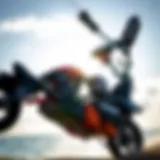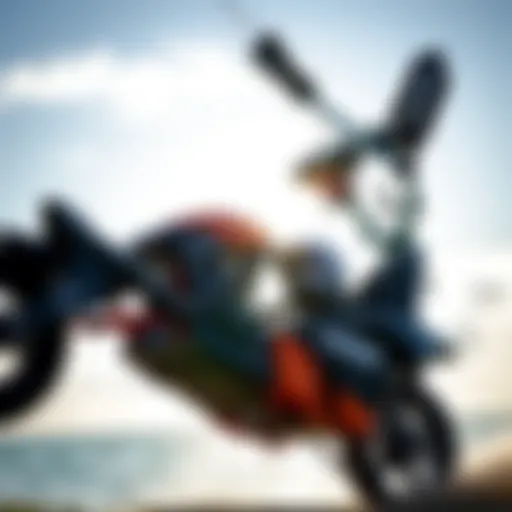Comprehensive Guide to Kitesurfing Bars and Lines
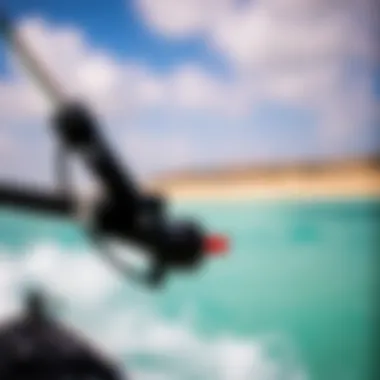
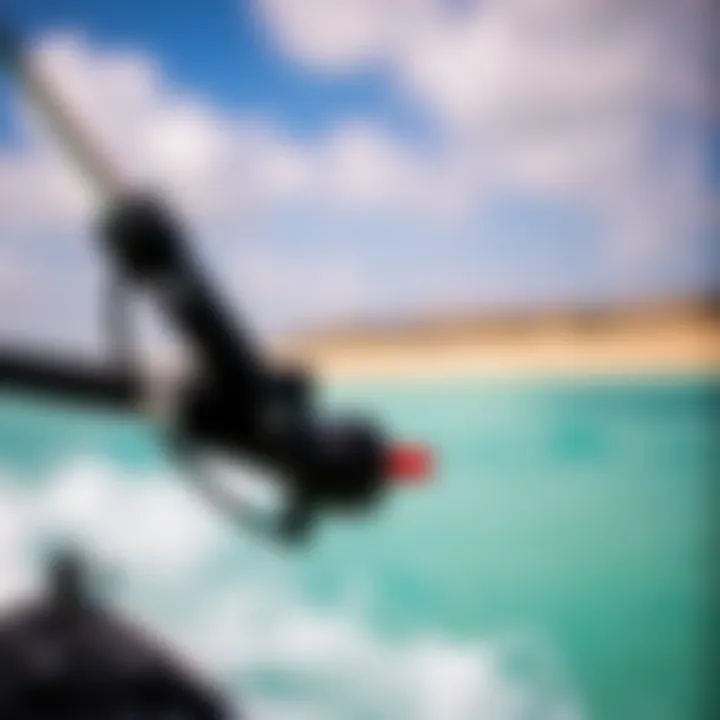
Intro
In the exhilarating world of kitesurfing, the bars and lines are akin to the steering wheel of a car. They form a critical connection between the rider and the kite, dictating not only maneuverability but also safety and performance. Any enthusiast knows that the right gear makes a world of difference when slicing through the waves or catching that perfect gust of wind. Yet, with the vast selection of equipment flooding the market, understanding the nuances of various bars and lines is crucial for anyone looking to maximize their experience and skills on the water.
Whether you’re just dipping your toes into this thrilling sport or you’ve been carving up the ocean for years, knowing your gear can make or break your sessions. It’s no secret that different types of bars and lines come with unique specifications and functionalities. This guide aims to peel back the layers and dig deep into what sets these components apart, alongside offering some juicy insights on selection, safety, and personal preferences.
In the sections to follow, we’ll provide invaluable gear insights that cater to all skill levels and technique tips that can elevate your riding game. Armed with the right knowledge, kiteboarders can navigate through the gustiest winds and tricky tides with confidence and style. Let’s set sail into this journey of discovery!
Understanding Kitesurfing Gear
Kitesurfing has become a thrilling water sport that combines elements from windsurfing, surfing, and paragliding. The equipment, particularly the bars and lines, plays a crucial part in ensuring that kiteboarders can harness the wind and navigate the waves effectively. Understanding kitesurfing gear is fundamental. Without this knowledge, one might end up misusing equipment, risking not just performance, but also safety.
The Role of Bars and Lines in Kitesurfing
At first glance, bars and lines might seem like mere connectors between the kite and the rider. However, they are vital in controlling the kite’s movement and responding to changing wind conditions. The bar helps manipulate the angle of attack, while the lines maintain tension and stability, allowing for better maneuverability. This synergy is particularly important during tricks or when facing sudden gusts. A properly functioning bar and line system ensures that the rider remains in control, contributing immensely to the overall experience.
Understanding the nuances of the bar's grip and the line's strength can significantly enhance performance. Kiteboarders will often find that even minute variations in these components can lead to noticeably different sensations while riding. For instance, consider the difference between two lines, one that has a bit of stretch and another that is completely rigid. Each will offer a distinct behavior with the kite, influencing how the rider reacts in diverse conditions. In a nutshell, the effectiveness of bars and lines can culminate in successful rides or disastrous falls.
Basic Components of Kitesurfing Equipment
To truly appreciate the mechanisms at play in kitesurfing, it's essential to familiarize oneself with the core components involved.
Here are some of the most vital elements:
- Kite: The heart of kitesurfing, it harnesses and transforms wind energy. Different shapes and sizes cater to various conditions and styles.
- Bar: A steering tool that connects the rider to the kite, allowing for directional control.
- Lines: They come in different categories, each serving distinct purposes. Main lines direct the kite; leader lines assist in steering; control lines help manage tensions and configurations.
- Harness: This is what the rider uses to attach to the bar, transferring the kite’s pull to the body. A well-fitted harness can make a big difference in comfort and control.
- Board: The surface upon which the rider stands. Boards vary in size and shape, catering to distinct riding styles.
To summarize, understanding kitesurfing gear is not merely an academic exercise; it's about grasping the relationship and function of each component involved. Being knowledgeable about what the gear does and how to maintain it can lead to better experiences on the water and ensure that the thrill of kitesurfing remains positive and exhilarating.
"In kitesurfing, equipment isn't just functional; it's an extension of your abilities and instincts on the water."
For more insights on kitesurfing components, you can check out Wikipedia on Kitesurfing.
Additionally, various forums like Reddit provide firsthand accounts and advice from seasoned kiteboarders.
Kitesurfing Bars: An Overview
Kitesurfing bars are not just simple accessories; they play a critical role in the overall kiteboarding experience. The bar acts as the control center, connecting the kitesurfer to the kite. This direct link influences how a rider navigates the water and achieves various tricks. Understanding the different types of bars and their features can greatly enhance one's performance and enjoyment on the water.
When selecting a kitesurfing bar, there are multiple factors to consider that directly affect ease of use and safety. Many kitesurfers tend to overlook the nuances of bars, resulting in suboptimal performance or accidents during their rides. This section aims to provide an in-depth look at the types of kitesurfing bars available and the key features that help inform smarter gear choices.
Types of Kitesurfing Bars
Fixed Length Bars
Fixed length bars are, as the name suggests, bars designed in a specific length that cannot be adjusted. These bars provide simplicity and reliability, making them a popular choice among beginners. The main feature of fixed length bars is their consistent design, which allows for predictability in handling.
One of the most compelling reasons to choose a fixed length bar is their weight. Lighter than many adjustable counterparts, they tend to improve overall kite responsiveness. However, their rigidity can be a drawback for more advanced riders looking for versatility in their session. In tight conditions or varying wind conditions, they might not provide the adaptability required. Hence, they tend to be best suited for straightforward riding rather than complex maneuvers.
Adjustable Length Bars
Next up, we have adjustable length bars, which offer the flexibility of customizing the length to suit different riding styles, conditions, or preferences. This characteristic makes them a versatile option for those who frequently change their kites or like to try different disciplines such as freestyle or wave riding.
What sets adjustable length bars apart is their adaptability—it is easy to switch from shorter lengths for increased control in strong winds to longer lengths when stability is needed. However, this adaptability does come with its caveats. The mechanisms that allow for adjustment can wear over time, so regular maintenance is essential to ensure reliable functionality.
High Aspect Ratio Bars
High aspect ratio bars are typically employed for kites designed for high-performance riding. They exhibit a different shape and provide optimized control and stability during advanced maneuvers. These bars often come with specialized features that sync well with high aspect ratio kites, giving the rider more control over their motion and enabling precise handling in various wind conditions.
The notable aspect of high aspect ratio bars is that they facilitate quicker and tighter turning capability, which can be a game-changer for advanced riders looking to push their limits. Nonetheless, they involve a steep learning curve for beginners. While desirable for their dynamic characteristics, they may not suit those still mastering basic techniques.
Key Features to Look for in Bars
Grip and Comfort
The grip of a kitesurfing bar plays a pivotal role in the riding experience. A good grip helps prevent slippage, enabling the kitesurfer to maintain control, especially in choppy waters or varying conditions. The material and texture of the grip are fundamental; many bars come with EVA foam or rubberized materials that can enhance comfort during extended sessions.
Comfort is also enhanced by ergonomic design features such as contoured shapes that align with the hands. On the downside, some designs may lack sufficient padding, leading to discomfort during longer rides, so it’s crucial to test different bars to find what feels right.
Safety Release Mechanisms
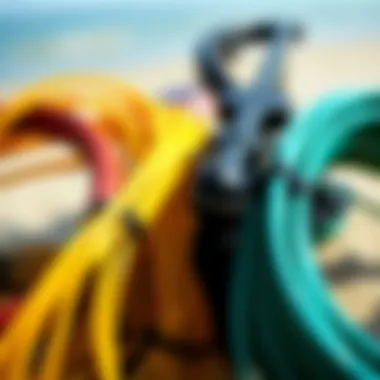
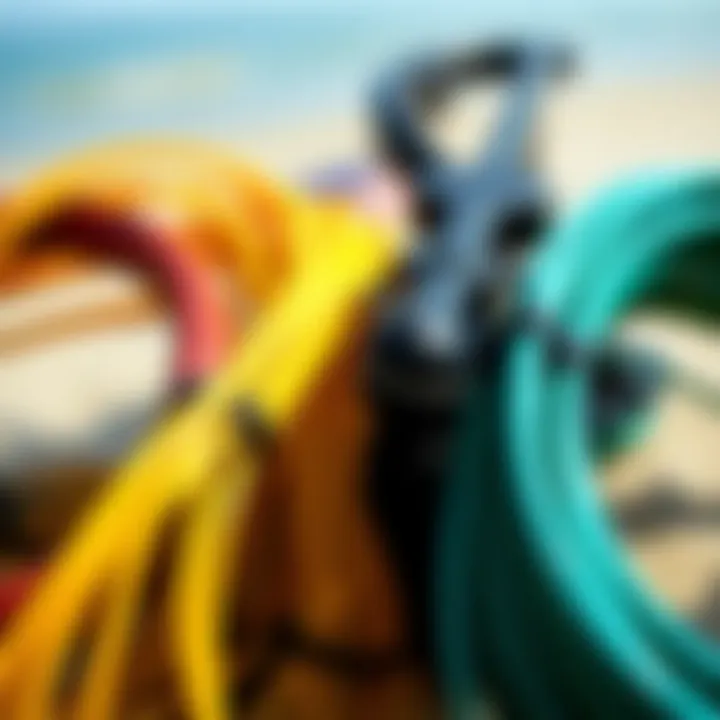
A well-designed safety release mechanism is arguably one of the most essential features of kitesurfing bars. This safety system allows the rider to quickly detach from the kite in the event of an emergency, making it crucial for all skill levels. A dependable safety release can save a rider from serious injuries during intense situations.
Mechanisms vary, ranging from simple push-button releases to more complex designs that allow for easier function when under tension. While effective, these systems can sometimes become tangled or gummed up with sand, affecting performance and reliability. Therefore, familiarity and practice with the release mechanism cannot be understated.
Materials and Durability
Durability is also a key consideration. Kitesurfing can be tough on gear, and materials used in bars should resist wear and tear. Common materials include aluminum for lightweight strength and high-quality plastics that offer flexibility without cracking.
A bar made with durable materials can withstand the harsh conditions of saltwater environments, ensuring longevity. However, less durable options may weigh significantly less but run the risk of failing prematurely under continuous use. Finding a balance between lightweight and durability is vital for the performance and safety of the kitesurfer.
Kitesurfing Lines: Essential Insights
Understanding kitesurfing lines is fundamental for any kiteboarding enthusiast. These lines serve as the crucial link between the kite and the rider. Picking the right lines impacts everything from control and maneuverability to safety during your ride. This section delves into the specifics of kitesurfing lines, shedding light on their importance and the choices available within this essential aspect of kitesurfing gear.
Overview of Kitesurfing Lines
Kitesurfing lines are not just ropes; they are the backbone of kite control. Made from strong synthetic materials, such as Dyneema or Spectra, these lines are designed to endure the tremendous forces exerted during use. The lines also come in various lengths and diameters, affecting the performance and handling of your kite.
Good quality lines provide better responsiveness and maintain stability in various wind conditions. Their structure impacts performance, ensuring that the kite behaves as expected when pulling on the control bar. A well-maintained set of kitesurfing lines can enhance your overall experience, making rides smoother and easier to control.
Different Types of Lines
Kitesurfing lines can be divided into three main categories, each serving a distinct purpose, but all crucial for effective kite control:
Main Lines
Main lines are the primary lines that connect the kite to the control bar. They are typically longer and designed to handle significant tension and loads during maneuvers. A key characteristic of main lines is their strength-to-weight ratio, which is vital for optimal performance.
One of the reasons main lines are popular is their versatility. These lines usually come in different lengths which can be tailored to the rider��’s preference, affecting the kite's angle of attack. Notably, their unique feature is the tension they can withstand without compromising safety. However, the downside is that if these lines suffer from wear and tear, they can break with little warning, leading to accidents.
Leader Lines
Leader lines serve as the intermediary between the kite and the main lines. They are shorter and typically have less tension than main lines, yet they are just as critical. The key characteristic here is flexibility, allowing the kite to respond quickly to rider input. This flexibility enhances the overall performance of the kite.
Leader lines are crucial for reducing the risk of tangling. They often come equipped with color coding, which simplifies setup. However, their unique feature is that they can wear down faster due to constant flexing, making regular checks necessary to avoid mishaps.
Control Lines
Control lines are the lines that the rider uses to steer the kite, providing the necessary feedback for adjustments in the air. One of their primary characteristics is their length variance, which can suit different riding styles and conditions. Riders appreciate how well they transmit the kite’s reactions, providing a direct connection to the kite.
The main benefit of control lines is enhanced responsiveness. They allow for quick turns and maneuvers, improving the kitesurfer’s ability to adapt to shifting winds. However, a notable disadvantage is that they can be sensitive to tensions and require careful adjustment to maintain optimal performance without compromising safety.
Selecting the Right Bar and Lines
Choosing the right bar and lines for kitesurfing cannot be overstressed. It’s not merely a matter of personal preference; it directly impacts your performance and enjoyment on the water. When you select equipment that fits your skill level, riding style, and the specific kite you are using, you set the stage for successful sessions. Conversely, the wrong gear can create unnecessary challenges, making your kitesurfing experience frustrating instead of exhilarating.
Assessing Skill Levels and Preferences
Every kitesurfer, whether a weekend warrior or a seasoned practitioner, has unique needs. Understanding your skill level is crucial. Beginners often benefit from equipment that provides easier handling and better stability. In contrast, advanced riders might seek out bars with more responsive control and precision.
Preferences also play a significant role. Think about the conditions where you typically ride. Are the winds light and gusty, or do you mostly kite in powerful winds? These factors will influence your choice of equipment tremendously. As they say, "One size doesn’t fit all," which is especially true in kitesurfing.
Understanding Kite Specifications
Compatibility with Kite Size
When you’re picking bars and lines, compatibility with your kite size cannot be overlooked. Each kite has a recommended bar size, making correct selection pivotal. Mismatched gear will not only hinder performance but also affect safety and control. A larger kite typically requires a longer bar to manage the increased power appropriately.
A key characteristic to consider is the recommended size range for bars specific to your kite brand. This compatibility ensures that you maintain control effectively while making precise movements on the water.
For example, a beginner kite might use a shorter bar because it allows simpler maneuvering. In contrast, experienced riders may lean toward longer bars for better control during drastic moves. Missing this detail can lead to a struggle in handling during critical moments, ultimately diminishing the fun you’re meant to have.
Inflation Type and Design
The inflation system of your kite also matters. It directly impacts the kite's performance and how it reacts under pressure. There are generally two types: single-point inflation and multiple-point inflation systems, and each has its pros and cons. Under this umbrella, easy setup and quick deflation options play important roles.
Kites with a single-point inflation system are often easier to inflate and deflate. This is favorable for those who value time efficiency. On the flip side, multiple-point systems might offer better performance at high speeds, although they could require a few more minutes of your time to set up properly. Each option serves different riding styles and preferences, creating a diverse marketplace to select from.
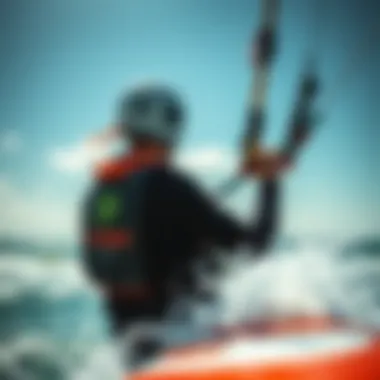
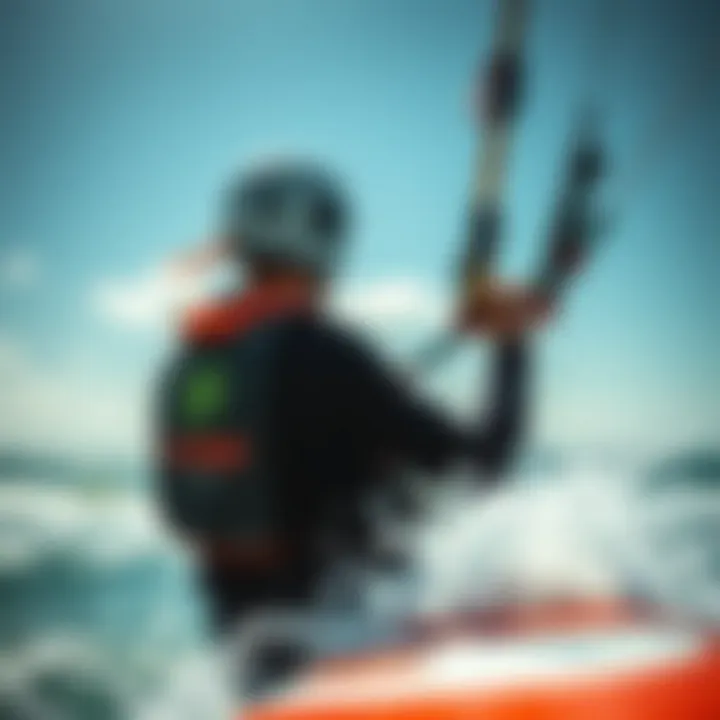
Selecting the right bar and lines tailored to your personal needs and your kite’s specifications ensures that each ride is safe, enjoyable, and aligns with your kitesurfing aspirations. It’s about finding the rhythm that works for you, as every detail matters when you hit the waves.
"The kite works best when bar and line selection is in harmony with the rider’s intentions."
End
In sum, understanding these elements will illuminate your path to becoming a proficient kitesurfer. Knowledge about compatibility with kite size and inflation type can steer your choices towards more enjoyable experiences and advanced skills on the water.
Safety Considerations When Choosing Gear
When it comes to kitesurfing, safety shouldn’t take a backseat. The thrill of soaring over waves can be exhilarating, but having the right safety measures in place is paramount. This section zeroes in on the critical safety aspects that every kiteboarder should be aware of when selecting gear, especially bars and lines. Each choice has implications, from personal safety to overall performance. Understanding these factors can mean the difference between a fun day on the water and a dangerous encounter.
Importance of Safety Releases
Safety releases are vital components in kitesurfing bars. They allow the rider to detach from the kite rapidly in emergencies, providing an essential escape route when things go awry. The mechanics of these releases can vary, but their core function remains the same: quick disconnect under pressure.
- Quick Activation: In situations like tangles or sudden shifts in wind, a safety release should be easily accessible and require minimal effort to operate.
- Reliable Design: Look out for brands that test their safety systems rigorously. A flimsy release can lead to malfunction when you need it most.
In real-world terms, imagine you’re riding hard and the kite takes a nosedive; without a dependable safety release, you could risk serious injury. Having one that works well can literally save your life. It's not just a feature; it's a necessity.
Regular Maintenance of Bars and Lines
Maintaining your kitesurfing gear is akin to keeping a well-oiled machine. Bars and lines that aren’t properly cared for can lead to all sorts of problems that might spoil your trip. Routine checks can prevent mishaps, ensuring that you stay safe while cutting through the surf. Here’s what to keep an eye on:
- Visual Inspections: Top of the list should always be inspecting your gear visually. Check for fraying lines, cracks, or signs of wear. Even the smallest imperfection can turn into a big problem.
- Cleaning: Saltwater and sand are enemies to your gear. Rinse your bars and lines after each session to prolong their life and maintain optimal performance.
- Replacements: Don’t hesitate to replace any part that shows the slightest wear. Ignoring a small tear can lead the whole line to snap at the worst possible moment.
Regular maintenance not only enhances performance but also significantly boosts safety.
"A stitch in time saves nine" – this saying rings true in the world of kitesurfing. Taking the time to maintain your gear means spending more time enjoying the ride.
Top Brands in Kitesurfing Bars and Lines
When it comes to kitesurfing, the saying "you get what you pay for" often rings true, especially regarding bars and lines. Selecting the gear from reputable brands not only guarantees performance but also assures safety on the waters. Quality manufacturers invest in research and design, ensuring their products can withstand the rigors of kiting while providing the precision control needed by riders. In addition, established manufacturers often have a track record of durability and innovation, making their gear a safe bet for both novices and seasoned kiteboarders alike.
In the following sections, we’ll take a close look at two major categories of brands: the established gear manufacturers that have carved out their niche over the years and emerging brands that are starting to make waves in the kitesurfing community.
Established Gear Manufacturers
Established manufacturers in the kitesurfing industry have built their reputations over time through a commitment to quality. Brands like Cabrinha, Naish, and Duotone have gained recognition for their reliable products. They have teams of engineers and kiteboarders who actively work on refining designs and materials.
- Cabrinha: Known for their robust construction and innovative designs, Cabrinha bars and lines offer an excellent balance of performance and reliability. Their quick-release systems are particularly noted for their effectiveness in emergency situations.
- Naish: This brand not only focuses on kites but also provides a complete suite of kitesurfing gear, including high-quality bars and lines. They prioritize comfort, which is evident in their grip designs.
- Duotone: Formerly known as North Kiteboarding, Duotone is revered for their engineering prowess. Their products frequently integrate cutting-edge technology and user feedback for continuous improvement.
Engaging with these established companies offers reassurance that your kitesurfing gear is not just a short-term investment; it's likely to last through many seasons on the water. Their global presence also means warranty and support are often within easier reach.
Emerging Brands to Watch
In addition to these seasoned players, a handful of emerging brands are shaking up the scene. These companies bring fresh ideas and often focus on sustainable practices or innovative designs that set them apart from traditional brands.
- F-One: Specializing in kitesurfing and stand-up paddleboarding gear, F-One is recognized for its ergonomic designs. They emphasize a user-friendly experience, seeking to improve ease and comfort for riders of all skill levels.
- Core: Known for their high-performance kites, Core's bars are increasingly praised for their lightweight design and effective line systems. This brand emphasizes performance while retaining simplicity in their designs.
- SABFoil: Although primarily known for foils, SABFoil is entering the kitesurfing bar market with innovative solutions that appeal to more eco-conscious kiteboarders. Their focus on sustainability offers an appealing option for environmentally minded consumers.
With each of these brands, there’s potential for discovery on what might suit your kitesurfing style best. Whether you prefer well-established companies or are keen to explore the latest options, there's no shortage of brands catering to a range of preferences.
"Investing in quality bars and lines is akin to ensuring a strong foundation. Without that, even the best kite can struggle to perform."
The End
The importance of choosing the right brand cannot be overstated. The gear you select has a direct impact on your experience in the water, from boosting performance to ensuring safety. As such, it’s worthwhile to delve deeper into these companies, understanding their philosophies and offerings. No matter your choice, remember that informed selections can significantly enhance your enjoyment and skills in kitesurfing.
User Experiences and Reviews
User experiences and reviews play a crucial role in understanding the effectiveness and performance of kitesurfing bars and lines. For many kiteboarders, whether seasoned surfers or novices, reviews from fellow enthusiasts often shape purchasing decisions. These testimonials provide insight beyond the technical specifications written by manufacturers. They offer practical knowledge about durability, performance under different conditions, and the comfort of using specific equipment.
When navigating the vast selection of gear available, feedback from the community becomes invaluable. Each review carries the weight of personal experience, shedding light on how certain bars and lines perform during a ride. Furthermore, they often highlight nuances that might otherwise be overlooked—like how a line handles during gusts or how a bar feels after hours of intense use.
Furthermore, many riders post their reviews on platforms like Reddit or Facebook, making it accessible for kiteboarders to seek advice or opinions. Here's why diving into user experiences is essential:
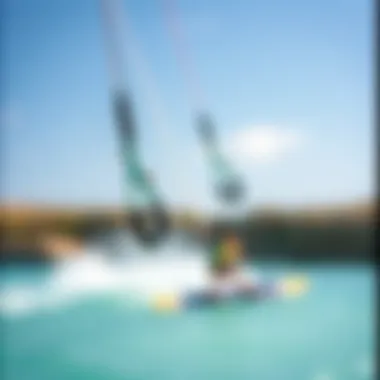
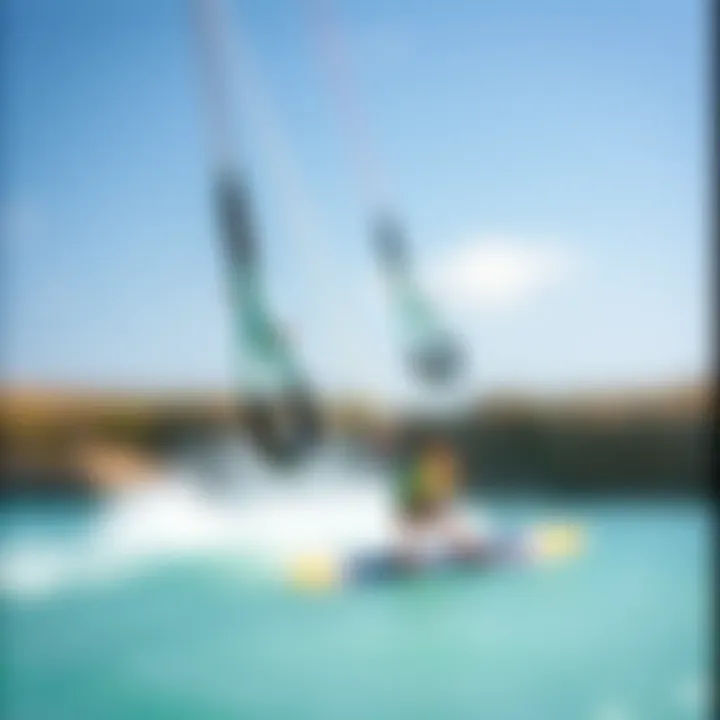
- Real-World Testing: Reviews frequently discuss wear and tear over time, which is critical since a product might look good on paper but fall short in real conditions.
- Passionate Perspectives: Many users are avid water sports enthusiasts, often detailing their adventures and how certain setups impacted their performance.
- Comparative Insights: Users frequently share side-by-side comparisons of gear they've tried, contributing to a more rounded understanding of what's available.
“The best insight often comes from the individual who has tested their gear in the field, not just the lab.”
Real-life Performance Insights
Understanding how different kitesurfing bars and lines perform in actual settings is critical. While manufacturers provide detailed specs, real-life performance insights come straight from experienced riders, who can explain how gear responds to conditions such as wind, waves, and personal riding styles.
For example, many users mention how certain bar designs might help with maneuverability or provide more control. A rider might note that an adjustable bar gives them an edge in tackling challenging wind conditions, while others might focus on the comfort of the grip during long sessions. Such feedback is invaluable, as it underscores the significant role gear plays in enhancing athletic performance.
Beyond control and maneuverability, reviews often delve into how gear feels—this can be the difference between an enjoyable day on the water and one filled with frustration. Lines that tangle easily or bars that cause blisters can ruin a session, and these nuances are best shared by those who've been there.
Comparative Analysis of Popular Products
Once an adventurer decides to explore particular kitesurfing bars and lines, comparative analyses come into play. Enthusiasts often compare popular products based on their personal experiences, pointing out strengths and weaknesses of each product.
- Brand A’s Fixed Length Bar: Many riders praise its simplicity and reliability but criticize it for limited adjustability in varying conditions.
- Brand B’s Adjustable Bar: Users enjoy the flexibility it offers, allowing for a tailored experience. However, some feedback suggests the adjustment mechanisms can be finicky and occasionally malfunction.
- Brand C’s High Aspect Ratio Lines: These lines are often regarded as providing extraordinary speed and responsiveness, but some users report issues with durability after extended use.
This detailed comparative analysis helps potential buyers determine which products align with their needs. Often, forums and review sites offer visuals and detailed breakdowns that illuminate which features are most beneficial.
In the end, by garnering a holistic perspective on user experiences and breaking down product comparisons, kiteboarders can find gear that resonates with their unique riding approach and environmental conditions. For more on gear reviews, check out Wikipedia or relevant threads on Reddit for deeper discussions.
Where to Purchase Kitesurfing Bars and Lines
When it comes to kitesurfing bars and lines, the right choice isn’t just about quality or performance; it’s also about securing that gear in places where you trust the source. Purchasing these critical components can make the difference between an exhilarating ride and an untimely accident. Therefore, knowing where to buy your equipment can lead to more informed decisions, peace of mind, and a better overall experience on the water.
Online Retail Options
The internet has transformed the way enthusiasts shop for gear. Online retail options are abundant and provide a wealth of knowledge at your fingertips. Websites like Amazon, Kiteworld and even specialized sites like Kiteboarding.com often feature extensive inventories and user reviews. When hunting for kitesurfing gear online, keep the following in mind:
- Wide Selection: Online platforms usually carry numerous brands and types of bars and lines. You can compare products side by side easily.
- User Reviews: Feedback from other kiteboarders can provide insights that you won’t find in standard product descriptions.
- Price Comparisons: With just a few clicks, you can find the best prices available, allowing you to snag a deal that won’t break the bank.
- Sales and Discounts: Many online retailers run promotions that offer steep discounts at certain times of the year.
However, don’t forget the importance of checking the return and exchange policies. It’s vital to have that safety net in case the gear doesn’t meet your expectations.
Local Shops and Workshops
While online shopping offers convenience, local shops and workshops carry their own unique benefits that can’t be overlooked. These establishments often serve as community hubs, fostering connections among kiteboarding enthusiasts. Here's why visiting a local shop can be a good idea:
- Personal Guidance: Experienced staff members can provide tailored advice based on your skill level and preferences, ensuring better gear choices.
- Hands-on Examination: It allows you to physically inspect the gear. Feeling the grip of a bar or inspecting line thickness can help solidify your decision.
- Immediate Availability: If you’re gearing up for a weekend trip, local shops often have stock available for you to take home immediately without waiting for delivery.
- Workshops and Clinics: Many local shops organize workshops that offer potential learning experiences on maintenance, safety, and new techniques.
Finally, visiting local shops fosters a sense of community. Joining local enthusiasts on the water not only enhances your skills but also builds friendships along the way.
"The best gear is the one that feels right in your hands. Take your time to shop both online and locally, and you’ll find what suits you best."
Combining both online and local purchasing methods can offer you the best of both worlds—convenience and hands-on experience. So, make your choice wisely.
Epilogue and Final Thoughts
Navigating the world of kitesurfing bars and lines is paramount for anyone wishing to excel in the sport. The conclusion serves as a pivotal area in this guide, encapsulating the essence of what has been discussed while reinforcing the significance of each element. Understanding the diverse types and qualities of gear can elevate not just performance, but also enjoyment and safety on the water.
A key takeaway from our exploration is the understanding of personal preferences and skill levels. Kitesurfing is a sport that demands a tailored approach to gear selection; what works for one rider may not suit another. The proper bar and line setup can have a substantial impact on responsiveness and control, directly affecting the overall ride.
Moreover, the importance of safety features cannot be stressed enough. As we delved into various releases and maintenance practices, it’s clear that being proactive regarding gear upkeep enhances safety and prolongs the life of your equipment.
Moving forward, kiteboarders should harness the insights gained from user experiences and gear reviews. Whether you’re eyeing local shops or online platforms for your next purchase, knowing what others have faced in terms of performance can guide you in making the best decision for your needs. As with most things, a wise choice today leads to greater adventures tomorrow.
"The kite flies but it is the rider who directs its path."
Summarizing Key Takeaways
- Individual Fit: Choose kitesurfing bars and lines that cater to your skill level and riding style. A beginner might prioritize easy control, while advanced riders may seek enhanced performance.
- Safety is Critical: Employ and maintain safety release mechanisms. Regular check-ups and careful inspection before rides can save lives.
- Do Your Homework: Engage with reviews and experiences shared by others. A well-researched decision leads to an enjoyable ride.
- Shop Smart: Whether buying in-store or online, take note of the specifications to ensure compatibility with your equipment.
Future Trends in Kitesurfing Gear
The landscape of kitesurfing gear is continually evolving, and staying informed about the latest trends can offer significant advantages. Emerging technologies are paving the way for improved materials and innovative designs that breathe new life into kitesurfing components.
One trend to watch is the increased integration of smart technologies. Many brands are now developing systems that allow for real-time tracking of wind conditions and kitesurfing performance metrics, which can be invaluable for data-driven improvements.
Surging interest in sustainability is leading manufacturers to explore eco-friendly materials without compromising durability. Expect to see more options made from recycled materials, which not only helps the planet but also appeals to environmentally conscious riders.
Lastly, customization is becoming increasingly mainstream. Riders now prefer setups that reflect their personal style, which includes varying colors, patterns, and even the choice of grip textures.
As these trends continue to unfold, it’s evident that the future of kitesurfing gear promises exciting advancements that could reshape how we interact with the wind and waves.




